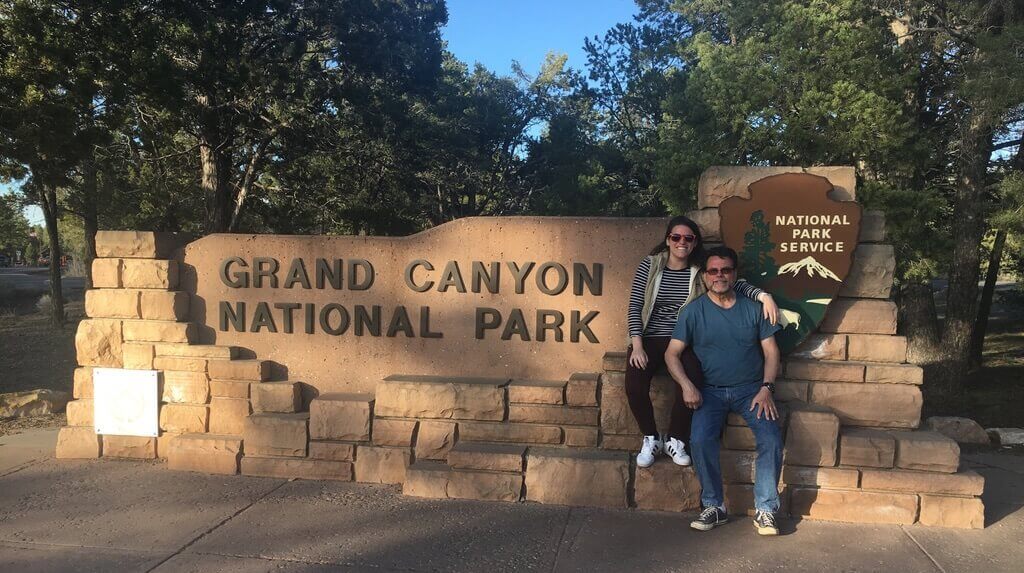
Written in memory of my goofy, loving, and one-of-a-kind dad, 1955-2019. TG.
The American Southwest is a part of our country that we yearn to get to know better. We’ve both visited the Grand Canyon separately, and Alex hiked Utah’s Mighty Five with his mom (check out our guide here) but these brief trips really just made us want to go back– soon and often.
As lifelong East Coast folks, we’re so accustomed to chaos: the traffic, the hustle-and-bustle, the frenetic pace of the cities we love, the exhaustion of the rat race we feel like we were funneled into without even noticing. Despite loving our urban trappings and extolling the virtues of our “car-free, tiny-apartment, organic-produce lifestyle” loudly and proudly, the truth of the matter is that finding peace and rest is so elusive. The American Southwest’s wide-open spaces, deep experiences of quiet and stillness, and jaw-dropping vistas are just the ticket.
When I was in my first year of grad school in D.C. and up to my ears in rational choice theory and other political science nonsense (which I truly thought at the time was my calling in life), my dad suggested a trip to a national park of my choice for spring break, just the two of us.
The broke grad student and aspirational world traveler was, of course, thrilled, but knowing what I know now– that I would lose my dad suddenly in 2019– that week in a dusty rental car fighting over the radio are more precious than ever.
We had so, so many trips we wanted to take together: hiking in Alaska, visiting where his family lived in Thessaloniki, and so many others in various stages of planning. He always inspired in me a deep love and appreciation for the outdoors and our world’s natural treasures– animals and plants alike. You always think you have more time than you do, and it’s all so, so precious.
This road trip will forever be one of my favorite memories with my dad, and I think you guys will love it, too! It’s a great mix of big cities (Vegas, LA); man-made and natural wonders (the Hoover Dam, Anza-Borrego Desert); vast landscapes (Joshua Tree, the Grand Canyon); and fun for any traveler.
Off we go!
Day 1: Fly into Las Vegas
Table of Contents
Toggle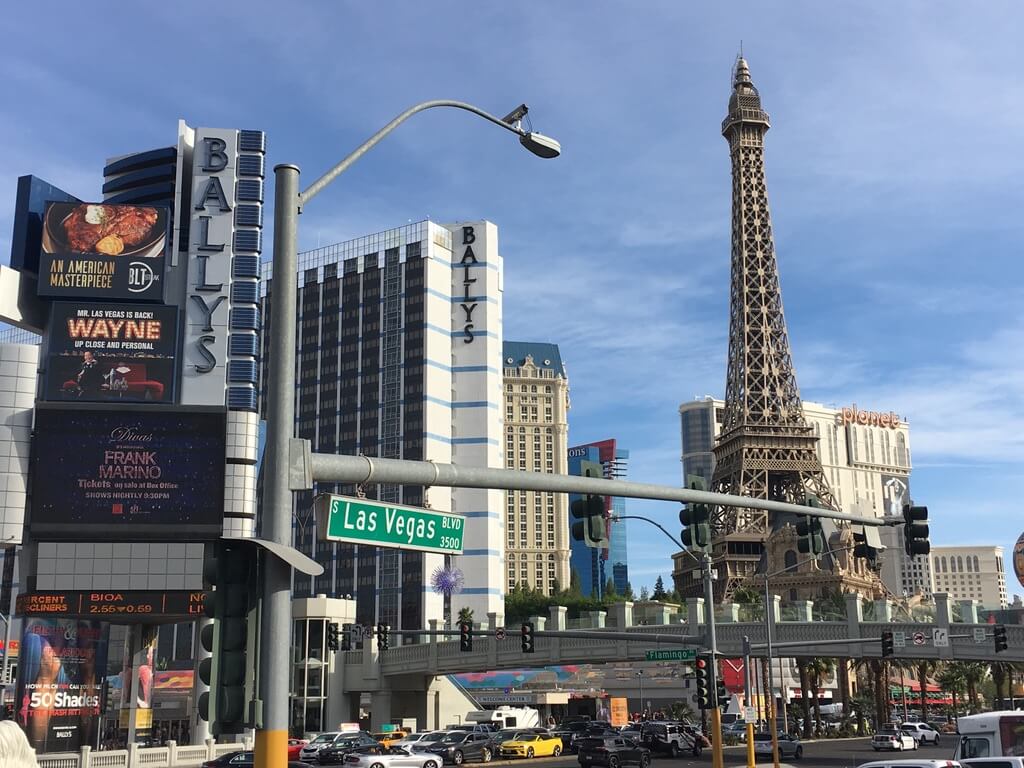
Oh, Vegas. What a weird place. To be honest, Vegas is not my cup of tea in any scenario, but I will always laugh at the fact that my first time visiting this famed world capital of poor decision-making was immediately prior to a hiking trip in the wilderness (and dressed as such) with my dad. Cargo shorts in Sin City? You betcha.
Once you land in Vegas, follow the signs to the car rental area to pick up your car. Note that we waited a very long time in line here (despite visiting in March, off-season), so be prepared for that and avoid making any plans too close to your flight’s arrival.
McCarran Airport is super close to downtown Las Vegas, about 10 minutes without traffic. Driving into the Strip area of Vegas is insane– surrounded by dry, desolate desert, you’re suddenly engulfed by neon lights and huge hotels everywhere, as well as the inexplicable presence of huge fountains (yes, in the desert) which is both jarring and environmentally cringe-worthy… but pretty to look at.
On the bright side (don’t want to sound too negative here!), Vegas has got to be the place with the most quality people-watching! All walks of life seem to converge here, from bachelorette parties to little old ladies and people in strange costumes. You name it, you’ll see it. We loved grabbing snacks at the 7-11 and just walking around checking out what everyone was up to.
There are also numerous enormous hotels along the Strip to pop in and out of– for the sheer excessiveness of the decor, as well as to get a little respite from the heat. Several of them have replicas of famous world sights (like the Eiffel Tower or an ancient Roman palace complex) with super impressive attention to detail.
Here’s a power-ranking of our Top 5 favorites:
- The Wynn’s flower arrangements and carousel made of flowers
- The Grand Canal at the Venetian (you can even take a gondola ride here!)
- The Eiffel Tower at the Paris
- The Great Pyramid at Luxor
- The complex of Roman-themed buildings at Caesar’s Palace
You can easily spend an afternoon working your way down the Strip, visiting each hotel lobby and marveling (or recoiling) from the grandeur and the different themes. Not being big gamblers, my dad and I did play a few slots together, capping our losses at $10. At one point we’d made about $80, but quickly lost it again. Alas!
Since we were only staying one night and it was the off-season, my dad wanted to splurge and stay at The Venetian. It was just as over-the-top as it sounds, and regrettably didn’t even include breakfast! Hot take: For this budget traveler, staying “on-Strip” was absolutely not worth it… and if I ever go back, I’ll definitely be in the market for tips for budget accommodations. Feel free to drop your budget highlights in the comments!
While in Vegas, I would definitely recommend taking in a show or two, budget permitting (they’re pricey.) My dad and I were torn between a magic show and a Cirque du Soleil show, and ultimately decided to go with Cirque du Soleil. There are tons of options, and if you haven’t seen Cirque before, you should absolutely check one out!
We ended up choosing to see “O” at the Bellagio, which was absolutely awe-inspiring and incredible– can’t recommend it enough! Also note that the Bellagio’s famous (infamous?) huge fountain goes off every 15 minutes starting at 8 PM, so you can likely catch it before and/or after the show. Seeing “O” was certainly the highlight of our time in Vegas, and I would love to see another Cirque du Soleil show someday for sure!
What did you think of Vegas when you visited? While my dad and I enjoyed spending a day there, we largely felt like fish out of water the whole time. (Maybe it was the hiking clothes? Oops.)
However, I hope I didn’t come off as overly negative here! While Vegas wasn’t particularly our cup of tea (we just couldn’t stop thinking about how much water those fountains waste in the desert!), I really wanted to write a post with tips for travelers using Vegas as a jumping-off point for national parks like we did: less focused on the gambling and partying that most people seek out in Vegas, and more on cool architecture and old-timey slot machine finds. That said, if gambling and partying is what you’re after, you’ll find it in spades!
Day 2: The Hoover Dam + Flagstaff
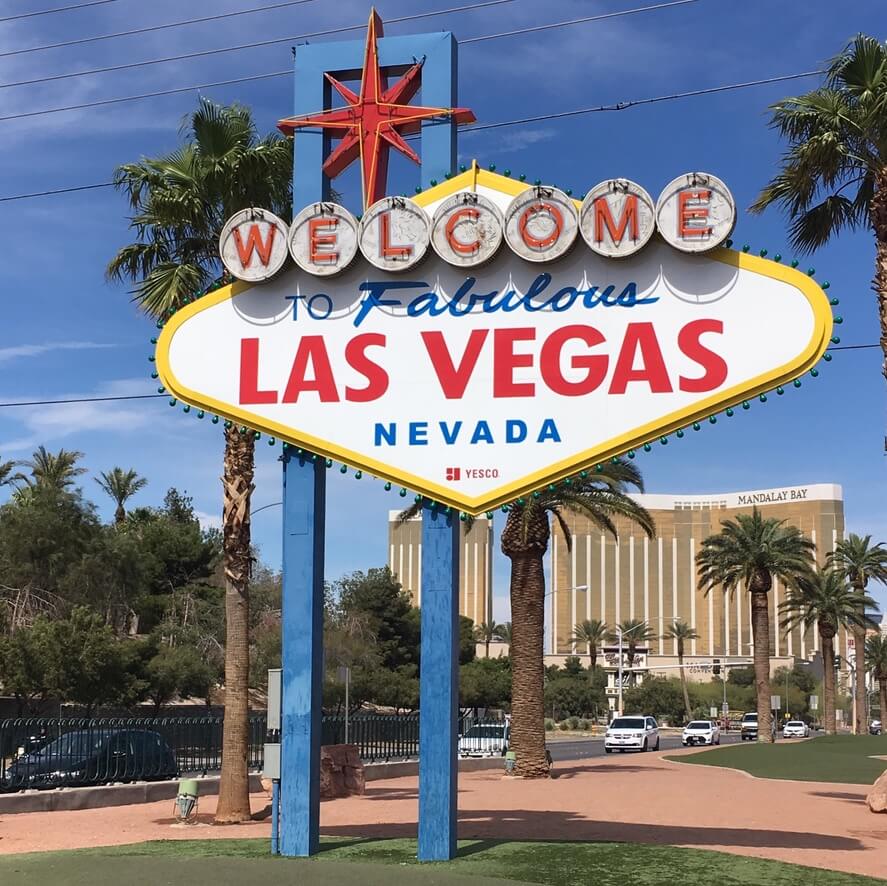 If you have a second day or half-day in Vegas, there are actually lots of outdoorsy options to explore, such as the Las Vegas Springs Preserve or Red Rock Canyon. Within Las Vegas, there is an acclaimed Mob Museum, as well as the National Atomic Testing Museum. Be sure to check out Fremont Street, the “hipster” part of Vegas, and be sure to snap a picture of the iconic “Welcome to Fabulous Las Vegas” sign on your way out of town. Tip: We visited early in the morning, and as you can see in our photo– no people!
If you have a second day or half-day in Vegas, there are actually lots of outdoorsy options to explore, such as the Las Vegas Springs Preserve or Red Rock Canyon. Within Las Vegas, there is an acclaimed Mob Museum, as well as the National Atomic Testing Museum. Be sure to check out Fremont Street, the “hipster” part of Vegas, and be sure to snap a picture of the iconic “Welcome to Fabulous Las Vegas” sign on your way out of town. Tip: We visited early in the morning, and as you can see in our photo– no people!
Our favorite casino experience was definitely the old-school slot machines at El Cortez— one of the last places you can play coin-operated slots in Vegas! It’s so fun to hear the quarters pouring out of the machine when someone wins big!
We hit the road early and made our way to our first stop of the day. About 30 miles southeast of Las Vegas (roughly an hour’s drive), you absolutely can’t miss a stop at the Hoover Dam.
This place is truly stupendous— a man-made wonder. Located right on the border between Arizona and Nevada, it’s what’s known as an “arch-gravity” dam, and supplies water, irrigation, and hydroelectricity to 7 states, fueling the creation of cities like LA, Vegas, and Phoenix. At the time of its completion in 1935, it was the largest dam in the world. Its construction was a massive, massive undertaking at the time due to the Colorado River’s raging currents, huge amounts of carbon-monoxide trapped in the blast zone walls, and the sheer amounts of dust, debris, and 800-foot drop-offs. There’s a fantastic walkway to explore, as well as a Visitor Center.
From the Hoover Dam, it’s about a 3.5 hour drive to Flagstaff, Arizona, which is a convenient place to stop for a little sightseeing and dinner. My dad and I thought Flagstaff was super adorable and really enjoyed walking around the downtown area and stretching our legs for a bit.
While here, check out the Walnut Canyon National Monument; the Wupatki National Monument (on US-89); the Lowell Observatory; and a meteor crater located on Old Route 66 about 37 miles away from Flagstaff.
It was so neat to drive around Route 66, too– while it no longer exists (due to upgrades in the 1960s and 1970s to the Federal Interstate Act), there are still some old buildings and motels with neon signs and other “blasts from the past” near Flagstaff.
From Flagstaff, it’s about an hour and a half to the Grand Canyon. We arrived and checked in fairly late in the evening.
Here, a note on where to stay at the Grand Canyon. This is a really important decision and one that must be made super far in advance.
When we first started planning our trip about 6 months beforehand, my dad really wanted to stay at the Phantom Ranch— cabins at the bottom of the Canyon. However, even with so much advance notice, this was already booked up for the spring! If you want to stay at Phantom Ranch, make sure you give them a call up to a year in advance, and keep in mind that it’s very pricey. Additionally, while your stay down there does include meals (since there’s nowhere else to get food), we found out that it’s very meat-heavy– not ideal for vegetarians like us. If you don’t eat meat, make sure you let them know!
If you decide not to stay at Phantom Ranch but do want to stay inside the park, you have 5 options, all managed by Xanterra Parks and Resorts: Bright Angel Lodge; El Tovar Hotel; Kachina Lodge; Thunderbird Lodge; and Maswik Lodge.
Here are some key differences, to ease your decision-making:
- Bright Angel Lodge: founded in 1935, designed by famed architect Mary EJ Colter and is a Registered National Historic Landmark. Originally designed as a more budget-friendly alternative to El Tovar Hotel, it is one of the pricier options today but gorgeous to look around and sit for a bit in the lobby.
- El Tovar Hotel: founded in 1905, designed by the architect for the Santa Fe Railway, Charles Whittlesey. Once considered the most elegant hotel west of the Mississippi, it is also a Registered National Historic Landmark. Due to its history and its location right on the south rim, this hotel is very pricey.
- Kachina Lodge: also situated directly on the south rim, Kachina is right in the middle of the historic part of the village. It is less fancy than El Tovar or Bright Angel and more contemporary, built in the 1960s.
- Thunderbird Lodge: very similar to Kachina and situated directly on the south rim. Thunderbird and Kachina are much more budget-friendly than El Tovar or Bright Angel, but still located directly on the rim, unlike Maswik.
- Maswik Lodge: located about a quarter-mile from the rim, in a beautiful Ponderosa pine forested area, Maswik is made up of about a dozen low-slung buildings, originally cabins when Maswik was a motor lodge. Note: The area is currently under construction, and their website warns of construction noise.
We decided to stay at Thunderbird Lodge— Thunderbird and Kachina are the most economical choices that are still located on the rim.
You can also stay outside the park in nearby Tusayan (7 miles away) at a variety of chain hotels. During peak season, there are shuttle services between Tusayan and the park that run frequently. After Tusayan, other lodging options are much further away– 30 to 60 miles. If camping is more your scene, there are campgrounds and RV parks at Desert View or Yavapai Lodge.
Your next decision is to check out the different room offerings, as some offer full or partial Canyon views. These are, of course, pricier than the non-view rooms. We opted for a non-view room to save money, assuming (correctly) that we would be spending pretty much all of our daylight hours outside– looking back, I stand by this decision.
We were very impressed with the eco-friendliness of the hotel. Everything was recyclable, and they had restrictions on what they provided you with (only a certain amount of coffee, linens, etc.) We had a fantastic stay at Thunderbird. It’s definitely a bit old-fashioned and the decor is quite dated, but you truly can’t beat being a few mere steps away from the Canyon rim!
Day 3: The Grand Canyon
Tip: To avoid having to leave the park, we decided to eat a big breakfast at The Fountain at Bright Angel Lodge nearby and skip lunch. By the time dinner rolled around, we were absolutely famished, and really enjoyed some pizza and beer at the Maswik Lodge Food Court & Pizza Pub. It ended up being a great idea not to leave the park and waste precious daylight hours seeking cheaper meal options for breakfast or lunch, and we had lots of snacks with us to sustain us during the day.
I strongly recommend starting your day at the Canyon View Information Center at Mather’s Point, to get set up with maps and everything you need to know, as well as look around at the exhibits they have there. You should also absolutely check out the ranger tour offerings! For a current list of offerings, see here. For guided tours, check out the Grand Canyon Field Conservancy’s offerings here.
Our top 5 (free!) tour recommendations:
- History tour at Verkamp’s Visitor Center
- Geology glimpse tour at Yavapai Geology Museum
- Rotating evening program (they often have star-gazing!)
- Hopi House, also designed by Mary EJ Colter
- Kolb Photography Studio Art and History tour
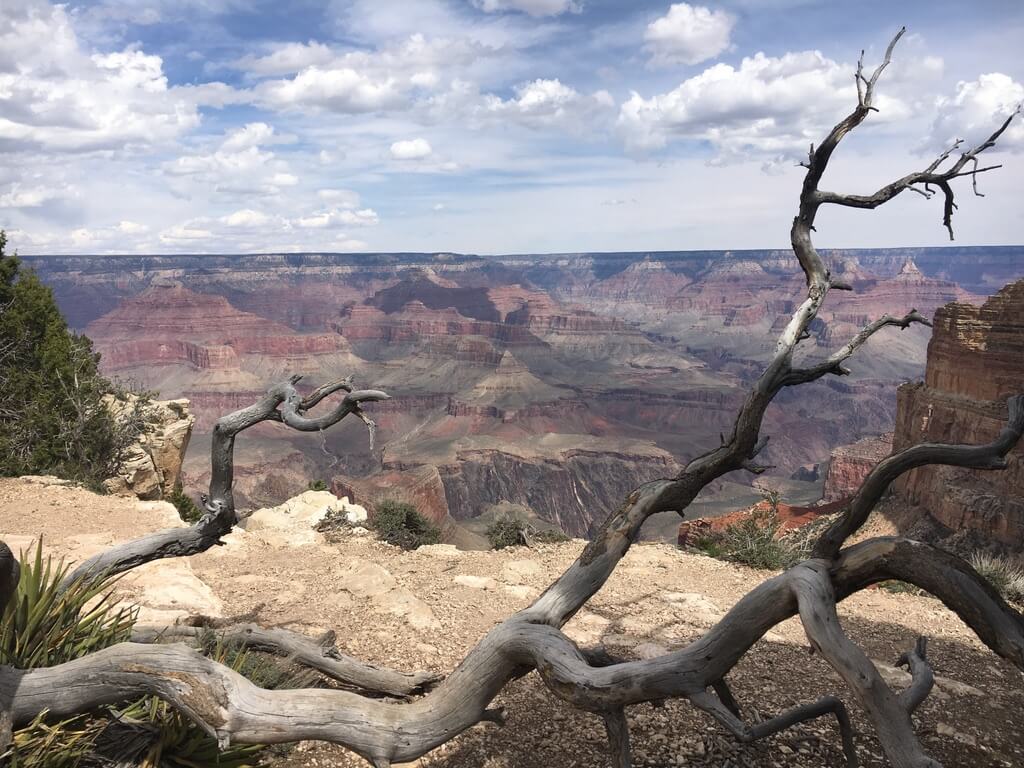
Your day will fly by hiking and exploring the Rim Trail, a well-marked and well-paved 12 mile walking trail from Kolb Studio to Hermit’s Rest. If the full 12 miles isn’t for you, the shuttle bus has frequent stops along the trail.
I would super recommend doing the whole thing, though, if you can– you may think that the quintessential rim view is the main thing to see, but the view changes a lot depending what part of the trail you’re on. Without a doubt, any and every part of the Rim Trail is absolutely beautiful– nothing I can write here can do it justice. I have never seen anything so beautiful and awe-inspiring as the Grand Canyon.
At the end of the day, be sure to check out the Desert View Watchtower and Lookout Studio, both also designed by Mary EJ Colter, at the end of the trail for a fabulous place to take photos off the edge of the Grand Canyon and watch the sunset.
For more south rim trails, check out this great resource from Hit the Trail.
Tip: Regardless of how long you decide to hike, keep in mind that the weather can be treacherous. Definitely plan to bring lots of water with you (though one big plus about the Grand Canyon is that there are lots of places to refill your bottle!) and wear quality shoes. I wore running shoes with good tread, but you may want to consider hiking boots for some of the tougher trails like Hermit or Grandview.
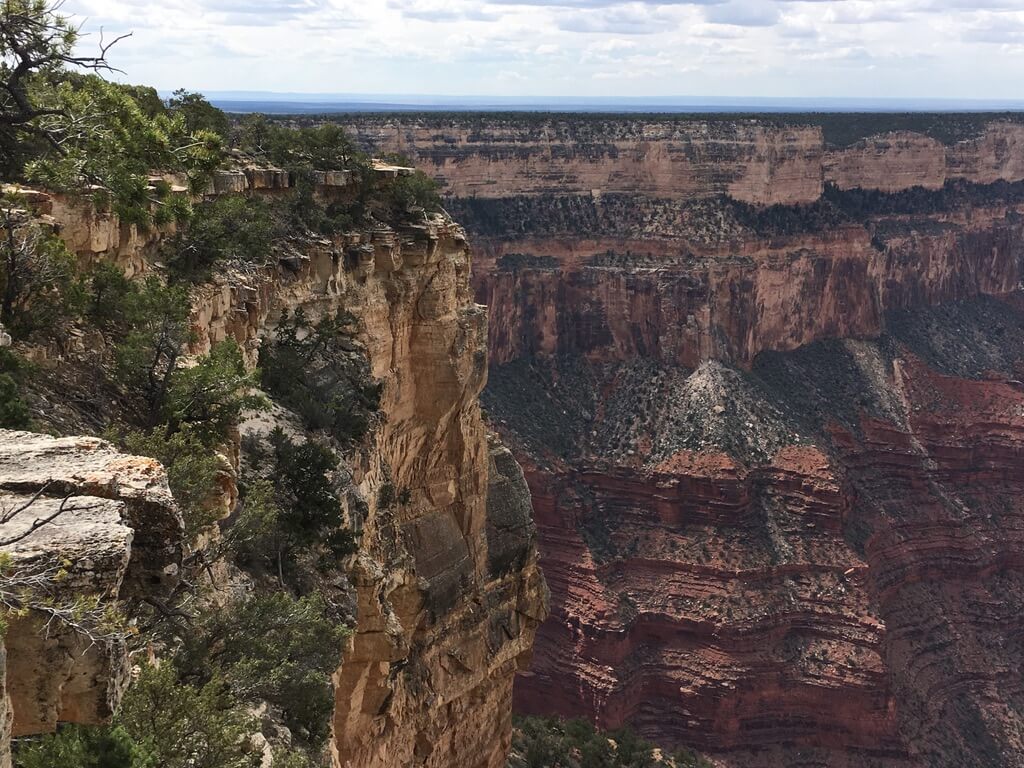
Day 4: Sedona Day Trip
Sedona, Arizona is about 2 hours away from the Grand Canyon, along the Red Rock Scenic Byway, thought to be the most scenic drive in Arizona. Sedona is gorgeous and super funky– worth a day trip if you have time.
As my dad and I arrived around lunchtime, we decided to get something to-go in town for a picnic at Red Rock Crossing. We stumbled upon a delightful local sandwich shop called Sedona Memories Bakery Café, which was just the ticket– fresh, home-made, and super vegetarian-friendly! For an exact location for a fabulous picnic experience, check out the “Crescent Moon Picnic Site” on Google Maps! We loved exploring the shallow, iridescent pools and gazing up at all the beautiful rock formations around us. It’s also a short walk from here to Buddha Beach, and offers gorgeous views of Cathedral Rock.
Speaking of Cathedral Rock, Sedona is well-known around the world for being a place where many vortexes are said to converge. It is said that you can feel these while seeing Cathedral Rock and Bell Rock, among other places, and they emanate a healing energy.
What is a vortex, you ask? According to VisitSedona.com, vortexes are “swirling centers of energy that are conducive to healing, meditation and self-exploration” where the Earth is “especially alive with energy.” After visiting a vortex, you should expect to feel “inspired, recharged or uplifted.” We saw lots of people meditating or practicing yoga in certain areas, which was super neat!
For hiking fans, you can’t miss Devil’s Bridge, the largest natural sandstone arch in the Sedona area and only 1.8 miles round-trip from the parking area. The altitude gain is only 400 feet, and most of the trail was originally paved for 4×4’s, so it’s super smooth! The views are really, really incredible– you can’t miss it!
In and near town, be sure to check out:
- the Amitabha Stupa, a Buddhist shrine located in beautiful 14-acre Peace Park;
- the Chapel of the Holy Cross built (incredibly) directly into the butte;
- the Hopi cliff dwelling and rock art site known as the Palatki Heritage Site;
- the Sedona Heritage Museum; and
- the Sedona Gallery District and its Art Walk
There is also a large Whole Foods in town if you want to stock up on trail mix or other goodies for the rest of the trip. Intriguingly, our cashier at Whole Foods told my dad that she was absolutely certain that she had known him in her previous life, so there’s that. The recognition was sadly not mutual, but perhaps she’d just spent more time at the vortexes?
Day 5: Grand Canyon to Joshua Tree
Today is a relatively long driving day, so make sure you have lots of snacks and a good playlist set! It’s about 5 and a half hours from the Thunderbird Lodge in the Grand Canyon to Twentynine Palms, the town closest to Joshua Tree National Park.
We opted to leave very early in the morning from the Grand Canyon, to maximize our time in Joshua Tree that afternoon. We made a beeline for the small Visitor Center upon our arrival, and checked in at our hotel.
In Twentynine Palms, we stayed at the Campbell House Hotel. Originally a homestead for an East Coast couple, Bill and Elizabeth Campbell, Bill was in poor health and was prescribed a desert atmosphere by his doctor to help his lungs. This was an interesting place to stay, with a lot of period furnishings, quirky additions, and a delicious breakfast included.
While in Joshua Tree, don’t miss out on these attractions:
- the Hidden Valley Walking Trail: a self-guided 1-mile walking loop with optional rock climbing;
- the Cholla Cactus Garden: a short (0.25 mile) walking loop surrounded by rare “teddy-bear cholla” cacti;
- Skull Rock: a large boulder that looks remarkably like a skull due to erosion over time; and
- the Oasis of Mara, the original settlement of Twentynine Palms by the Serrano tribe. Check out the trail and Visitor Center here, too!
While we were there, Joshua Tree was experiencing what is known as a “super-bloom,” with wildflowers in bloom everywhere. If you can plan a visit during a super-bloom, you absolutely should.
Day 6: Joshua Tree, Anza-Borrego Desert, LA
In the morning, finish up any hikes you missed the day before in Joshua Tree, and then hit the road to Anza-Borrego Desert State Park– about 2 hours from Joshua Tree.
Anza-Borrego Desert State Park is California’s largest state park– 600,000 acres of pristine desert wildlife in the Colorado Desert. For current tour offerings, check out this Visit California page.
If you have time before the park closes, check out Antelope Canyon near LA, too!
Note: Keep in mind that the traffic around LA is absolutely brutal. While Google Maps says it takes 3 hours from Anza-Borrego to LA, the traffic situation could stretch this out by several hours.
We ended up arriving in LA quite late in the evening, and opted to stay at a small boutique hotel called Hotel Beverly Terrace. It had a lovely, fresh included breakfast and free parking.
Day 7: LA
Oof, with only one day in LA, what do you do? My dad and I ended up spending a large amount of time just driving around and exploring, sometimes parking the car to walk around a bit in each area.
Note that one day in LA is really not enough! I would love to go back and check out in particular the food scene in LA, and unfortunately didn’t have enough time on this visit.
Don’t miss:
- Hollywood:
- the iconic Hollywood sign (tip: drive to Runyon Canyon for the best view);
- the Hollywood Walk of Fame and the TCL Chinese Theatre, and
- the Hollywood Forever Cemetery
- Beverly Hills:
- Walking around Rodeo Drive for quality people-watching
- Beverly Gardens Park is beautiful
- The Beverly Hills Hotel is likely one of the world’s most famous hotels, and has a really fun tropical theme
- Greystone Mansion (or Doheny Estate) has been the backdrop for lots of movies, such as Star Trek, The Social Network, and others.
- Drive around Mulholland Drive to see some of the area’s most exclusive housing, as well as beautiful views of the San Fernando Valley and the Hollywood sign. Note: TimeOut has a great guide to “joyriding Mulholland” here.
- If you’re looking for a museum to spend some time in, check out the Getty Center or LACMA, or even the Griffith Observatory!
In the afternoon, we took a quick drive down to the Santa Monica Pier and the Venice Beach boardwalk— only about a half hour from LA, but a totally different vibe.
The views of the ocean from the Santa Monica Pier are really beautiful, and the people-watching in Venice Beach is really high-quality.
Note: While visiting Santa Monica and Venice Beach was a really fun way to spend an afternoon, we didn’t anticipate that the traffic would be absolutely insane coming back into LA. Despite it only being about 3:30 in the afternoon, rush hour had certainly already begun!
What do you think of this road trip? Too much driving? Not enough? While we certainly pushed it some days, we overall thought that we struck a good balance between R&R, hiking, and covering as much ground as we can. Have you done a similar trip? What did you think? Let us know in the comments!
